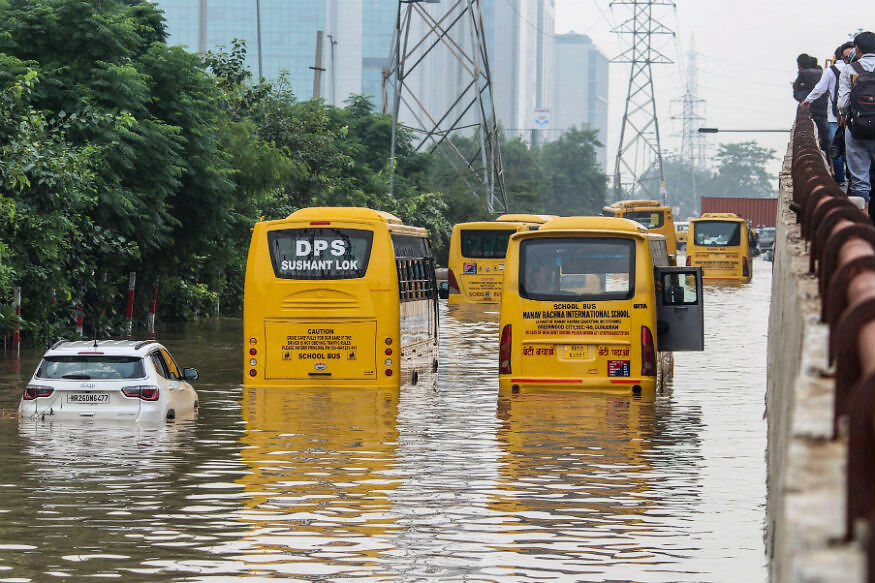
views
August has become a feared month in the Millennium City of Gurgaon. The overnight shower brought the cyber hub, our showcase to the western world, to a grinding halt on Tuesday morning.
Gurgaon is not alone. The whole of National Capital region (NCR), which has witnessed most rapid speed of urbanisation in the past 25 years, is increasingly feeling the ‘wrath’ of the annual Monsoon rains.
Be it Gurgaon, Ghaziabad, Noida, Faridabad or even parts of the national Capital, all linked up by swanky roads and lined by spic and span apartment blocks are increasingly being visited by the fear of deluge years after year. Why is this happening? We stop asking this question as soon as the Monsoon season is over.

(Buses wading through rain water in Gurgaon)
In mad rush, we forget that it’s the rivers which are having their revenge on the urban settlements. About a decade ago, an enthusiastic green activist from Ghaziabad had taken me to the banks of Hindon river near Mohun Nagar. He had showed me how the government was changing the natural course of the river to reclaim some precious land to be allocated to builders for the development of residential areas, what’s today is Rajnagar Extension. To a question on what was his objection to channelising a stream reduced to a “nullah” (drain), the passionate green warrior had replied that the worth of the “nullah” is known each time there is a heavy downpour.
He had pointed to deluge in Mumbai in 2005 and said that it happened because the builders, politicians, and bureaucrats devoured Mithi river. On July 26 every year, people recall the mayhem caused by the floods which brought the metropolis to a standstill. Large numbers of people were stranded on the road, as they returned home from work that evening. Water logging on railroads halted Mumbai’s lifeline as local trains stopped operating. This caused a heavy rush on the roads, leading to vehicular logjam. Worse, the mobile services too collapsed.
A study carried out later showed that due to heavy downpour, Powai Lake had started overflowing and discharging water into the Mithi River. In normal course, the water should have got drained because of the prevalent low-tide. But that did not happen because the accumulated water from the first flood wave had yet not flushed out effectively during the ebb period because of a choked drainage system caused by the encroachment into the river.
Two years ago on July 28, Gurgaon had faced similar jams as it faced on August 28 this year. If it was Mithi river in Mumbai, in Gurgaon, it’s Sabi which is having its revenge. The river was strangled when the planners senselessly metamorphosed Gurgaon from a green district of the national capital region into a concrete jungle.
The story of deluge in national Capital’s famous IT-suburb is traceable to the connivance of the builder mafia with the state government. The two together devoured a complete river flowing through the district, which was the sole source of natural drainage in the area. According to people working towards retaining natural topography of the National Capital Region, in 2010 the riverine land of Sabi river, which flowed through villages, including Ghata, Gwal Pahadi, Behrampur, Maidawas, and Nangli reaching Badshahpur was included in R (residential)-zone of the city’s Master Plan 2025.
The river had a clear course till Pataudi railway station and thereafter spread into distributaries. Its flat dry bed soaked water during the Monsoon showers. In case of heavy rainfall, its course took the flow to Nazafgarh drain, and onward to Yamuna.
Sabi river started from Aravalli hills in Alwar district of Rajasthan and flowed through Rewari and Gurgaon districts of Haryana before joinging Yamuna through Nazafgarh canal in the national Capital. Today, in the Master Plan, the development agencies have replaced the river with a covered drain and a road running over it. No wonder, the covered drain has repeatedly proved inadequate to take the load of heavy rainfall.
In 2016, 48 millimeter of rain in a short period of one hour and 15 minutes led to a 16 hour 25 km-long jam on Delhi-Jaipur National Highway, which could be opened only after taking emergency measures, including imposition of Section 144 of CrPC asking people not to come out on the roads. Thankfully, this year it was somewhat better.
If the deluge has happened in Gurgaon by devouring Sabi river, Ghaziabad-Noida, the eastern suburb of the Capital, faces the same fate every Monsoon for similar reasons. To facilitate creation of residential hubs, residents of Karera village in Ghaziabad point towards the construction of a bridge on the Hindon river. For the 800m-long bridge, which connects the Hindon Expressway with Karera Road (coming from Wazirabad), an embankment was raised across the river, which has somewhat changed the course of the Hindon.
The river now flows close to Karera village and the threat of inundation is constant during the Monsoon months. Villagers point out that in 1978, incessant rains caused flood in the Hindon. This had led to the snapping of Delhi-Ghaziabad link road for days. The National Highways, too, had sunk several feet into floodwaters and the railway link was broken.
Such floods in the life of a river can never be ruled out. The banks of Hindon in those days had no residential settlement. Today there are several of them. If the floods ever revisit Hindon, a deluge awaits these posh colonies.
But should they blame the Monsoon for it. For the residents of Karera village and Raj Nagar Extension, which has come up on the other side of the river, Monsoon also brings good news. The rains regenerate this dying river, which otherwise, through the year, has black water with a very foul smell and menacing mosquitoes.
However, Hindon was not a dying river till about two decades ago. So were the other tributaries of Yamuna, which have suffered most at rapid urbanisation and mad industrialisation of the National Capital Region.
(The writer is a senior journalist. The views expressed are personal.)




















Comments
0 comment